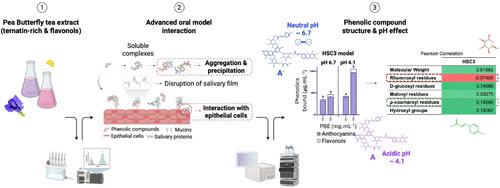阴蒂茶涩味的分子研究:酚类结构、口服成分和pH的作用
IF 6.2
1区 农林科学
Q1 AGRICULTURE, MULTIDISCIPLINARY
引用次数: 0
摘要
涩味是植物性产品的一个关键感官属性,通常与花青素和黄酮醇等酚类化合物有关。本研究利用人唾液、口腔黏膜膜和HSC3口腔上皮细胞组成的细胞模型,探讨了蝴蝶豌豆花茶涩味的分子基础。具体来说,它旨在(i)评估口服成分对酚类化合物结合的贡献(萜苷,黄酮醇);(ii)评估化合物特异性相互作用;(iii)确定ph值的影响。观察到与HSC3口腔细胞的显著相互作用,尽管被唾液蛋白抑制。酚类化合物的结构特征也调节了相互作用:对香豆醇基残基增强,而鼠李糖基残基减弱。酸性条件下,通过中性quinoidal碱促进与上皮膜相互作用的结合,而在中性pH下,阴离子形式被带负电的口腔细胞排斥。这些发现阐明了酚类结构、口服成分和pH值如何控制口服相互作用,为涩味感知提供了分子视角。本文章由计算机程序翻译,如有差异,请以英文原文为准。

Molecular Insights into the Astringency of Clitoria ternatea Tea: Role of Phenolic Structure, Oral Constituents, and pH
Astringency is a key sensory attribute in plant-based products, often linked to phenolic compounds, such as anthocyanins and flavonols. This study explores the molecular basis of astringency in butterfly pea flower tea using a cell-based model comprising human saliva, oral mucosal pellicle, and HSC3 oral epithelial cells. Specifically, it aimed to (i) assess the contribution of oral constituents to phenolic compound binding (ternatins, flavonols); (ii) evaluate compound-specific interactions; and (iii) determine the influence of pH. Significant interactions with HSC3 oral cells were observed, though inhibited by salivary proteins. Structural features of phenolic compounds also modulated interactions: p-coumaroyl residues enhanced, while rhamnosyl residues reduced them. Acidic conditions promoted binding through the neutral quinoidal base of ternatins interacting with epithelial membranes, whereas at neutral pH, anionic forms were repelled by negatively charged oral cells. These findings clarify how phenolic structure, oral constituents, and pH govern oral interactions, providing molecular insight into astringency perception.
求助全文
通过发布文献求助,成功后即可免费获取论文全文。
去求助
来源期刊
CiteScore
9.90
自引率
8.20%
发文量
1375
审稿时长
2.3 months
期刊介绍:
The Journal of Agricultural and Food Chemistry publishes high-quality, cutting edge original research representing complete studies and research advances dealing with the chemistry and biochemistry of agriculture and food. The Journal also encourages papers with chemistry and/or biochemistry as a major component combined with biological/sensory/nutritional/toxicological evaluation related to agriculture and/or food.

 求助内容:
求助内容: 应助结果提醒方式:
应助结果提醒方式:


